| | Purpose of survey | Methodology | Survey results | Specialty crops in Western Canada | Specialty cops by census division in Alberta | Exports of Alberta speciality crops | Markets for selected specialty crops | Economics of specialty crop production | Acknowledgment | Contact
.
Purpose of Survey
To address some of the data and information needs of the specialty crop industry in Alberta, the Alberta Agriculture and Forestry, Economics and Competitiveness Branch, Statistics and Data Development Section conducts an annual specialty crop survey. Now into its twenty-eighth year, the survey captures data on area, yield and production for specialty crops grown in the province.
Data gathered from the survey are used primarily to generate related provincial and sub-provincial (Census Division) estimates. In turn, these estimates are used to validate some of the Alberta statistics produced by Statistics Canada, as well as to provide industry and other stakeholders with benchmark data for some of the “new” and emerging crops.
Methodology
The Alberta Specialty Crop Survey, which is provincial in scope, collects data through a non-probability sampling procedure. In January 2012, survey questionnaires were mailed out to 2,623 specialty crop producers across the province. The questionnaires specifically asked survey participants to provide information on the type of specialty crop grown, area (seeded and harvested acres), and yield for 2011. Survey participants were informed that participation in the survey was voluntary. Moreover, all individual responses are kept confidential under the provisions of the Federal Statistics Act, as well as under the Provincial Freedom of Information and Protection of Privacy (FOIP) Act. As of June 28, 2012, a total of 663 questionnaires were returned. Of this total, 572 were usable and partly formed the basis in the generation of the Alberta 2011 specialty crop estimates.
Survey responses received were reviewed for data completeness, validated and entered into an electronic database. The data was then subjected to computerized analyses, the results of which were rolled up into group summaries, to preserve data confidentiality of individual survey respondents. In turn, the group summaries, in conjunction with information from provincial specialists of ARD, industry, and published sources (e.g. Statistics Canada), were used to 0generate the provincial and sub-provincial (Census Division) estimates, where appropriate.
It cannot be over emphasized that extensive consultation is done with ARD’s provincial specialists and industry in the development of the provincial/sub-provincial estimates. Provincial specialists are acknowledged for the invaluable insights they offer on crop conditions and yields, particularly when attempting to firm up some of the sub-provincial estimates generated from the survey. Similarly, administrative data on yield and crop area grown under private contracts also add value to the estimates.
It should be noted that the estimates are subject to error. Some of the possible sources of error include data coding, data entry and tabulation. Nonetheless, we believe that the statistics published in this report are reliable estimates for Alberta.
Survey Results
Area, yield and production in Alberta
In Alberta the term “specialty crops” refers to the following crops: dry peas, chick peas, dry beans, fababeans, lentils, mustard seed, sunflower seed, grain corn, silage corn, triticale, canary seed, sugar beets, potatoes, forage seeds and other field crops.
In 2011, the seeded area of specialty crops decreased compared to a year earlier. High prices as well as good economic returns for grain and oilseeds were the key drivers for the decline of specialty crop acreage. The total provincial seeded area, excluding potatoes and forage seeds, was estimated at 1.11 million acres, down 20 per cent, from 1.39 million acres in 2010 (see Figure 1). Of the total seeded area, 1.05 million acres or 95 per cent were harvested for grain production. To offer some perspective, shown in Figure 3 on page 4 is the percentage distribution of specialty crop seeded acreage in 2011, by crop type (i.e., pulse crops, oilseeds, corn, forage seeds, and other crops).
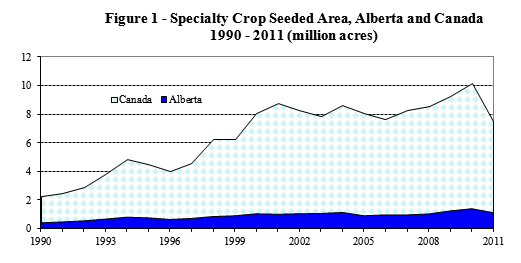
Source: Statistics Canada; and Alberta Agriculture and Rural Development
The 2011 crop growing conditions were mainly favorable in most areas of the province, however seeding was slower across the province due to cool temperatures in March and April and several precipitation events in the spring. The rain received throughout the summer resulted in soil moisture reserves being adequate to excessive in all regions. The warm and dry weather during September and October provided producers with the opportunity to make good harvest progress with the additional benefit of above average crop quality. However, damp weather in early November resulted in many crops in the northern part of the province being taken off wet and requiring drying.
Provincial average yields for most specialty crops were above their respective 10-year averages (2002-2011) outlined in Tables 1 and 4. The provincial average yield for dry peas in 2011 was estimated at 42.6 bushels per acre. This was nine per cent higher than in 2010, and 21 per cent above the 10-year average. With the majority of its acreage in southern Alberta, mustard seed produced an average yield of 941.0 pounds per acre in 2011, 11 per cent lower than in 2010, but still 11 per cent above the 10-year average. For triticale, the provincial average yield was 47.2 bushels per acre, 21 per cent lower than in 2010, and six per cent above the 10-year average.
The estimated provincial average yields for specialty crops under irrigation were above the 10-year average. For dry beans, the provincial average yield was estimated at 2,370 pounds per acre, 36 per cent higher than in 2010 and 10 per cent higher than the 10-year average. For potatoes, the provincial average yield was 32,800 pounds per acre. This was four percent above the 2010 yields, and at par with the 10-year average. The provincial average yield for sugar beets was 25.8 tonnes per acre, 29 percent higher than in 2011 or 16 per cent above the 10-year average.
Specialty crops in Western Canada
The results of “Alberta 2011 Specialty Crop Survey”, and Statistics Canada’s “Production of Principal Field Crops, November 2012” indicate that total seeded and harvested acres of specialty crops in Western Canada in 2011 decreased from a year earlier. This reflects smaller areas in all provinces in Western Canada.
In 2011, the total seeded area of specialty crops in Western Canada was estimated at 6.91 million acres, down 27 per cent from 9.47 million acres in 2010. On a provincial basis, Saskatchewan with 4.84 million acres, accounted for 70 per cent of the Western Canada total, while Alberta and Manitoba accounted for 16 per cent and 13 per cent, respectively. The specialty crop seeded area in British Columbia was extremely small, less than one per cent of the Western Canadian total. Similar to seeded area, the total harvested acreage in 2011 decreased 25 per cent from a year earlier, to 6.68 million acres.
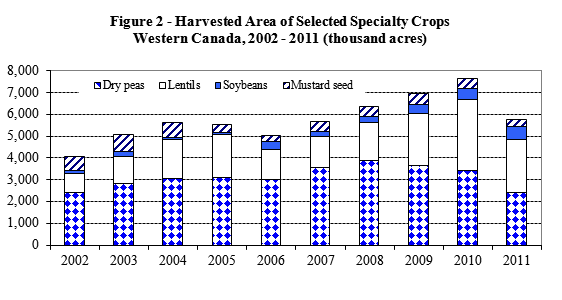
Source: Statistics Canada; and Alberta Agriculture and Rural Development
The four largest specialty crops grown in Western Canada in 2011 were dry peas, lentils, soybeans and mustard seed. Together, these crops accounted for 5.90 million acres, or 85 per cent of the total area seeded of specialty crops. Lentils was the largest specialty crop, accounting for 2.56 million acres, or 37 per cent of the Western Canada total. Dry peas were next, with seeded acres totaling 2.44 million acres (35 per cent of the total), while soybeans (575,000 acres) and mustard seed (327,958 acres) represented eight per cent and five per cent, respectively. Shown in Figure 2 below is the harvested area of the top four specialty crops in Western Canada. Historical statistics on seeded area and production for selected specialty crops are presented in Table 8 on page 16 and 17.
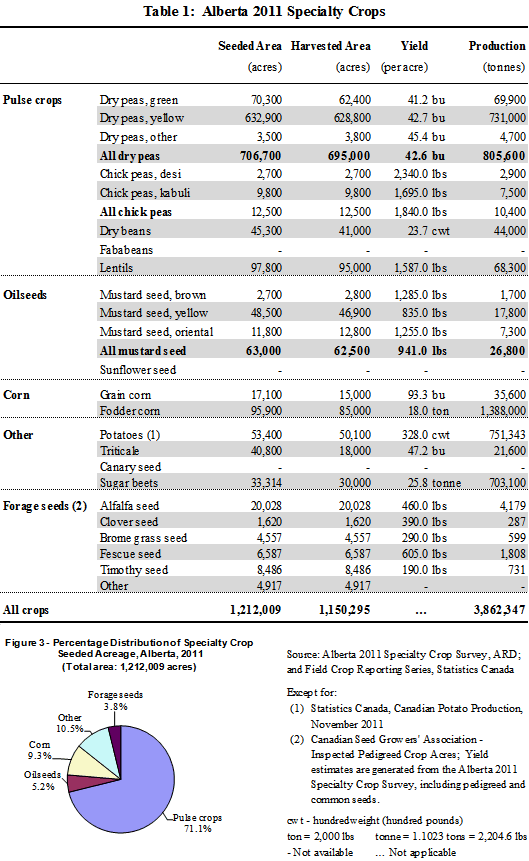
Figure 4 - Alberta Census Divisions, ID, MD and Counties Map
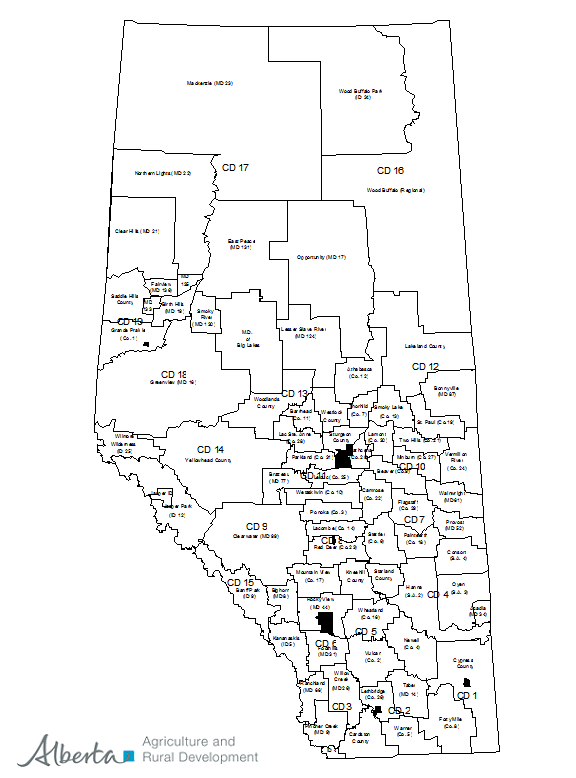
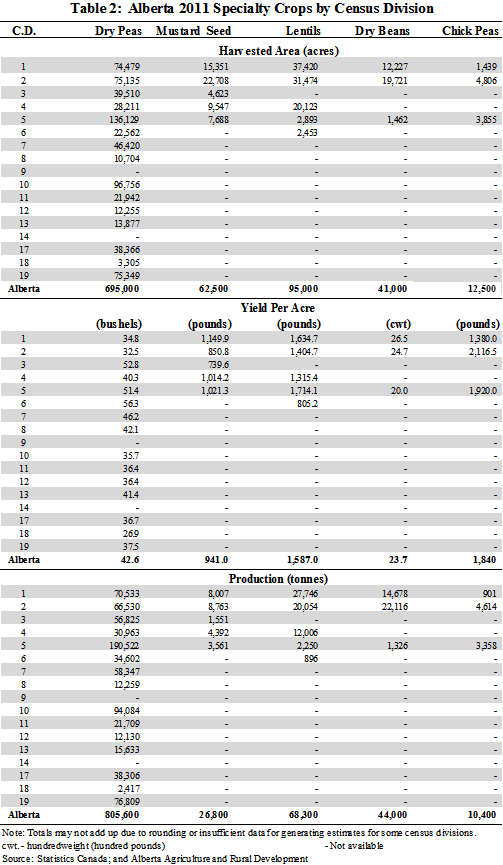
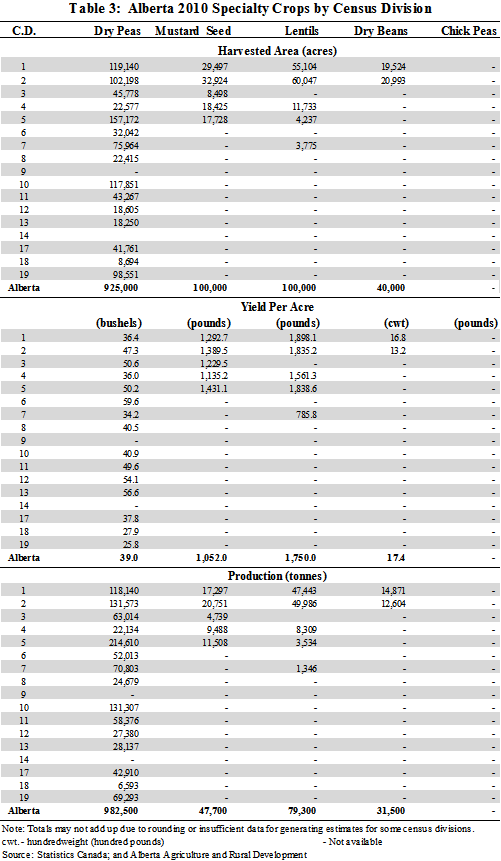
Specialty Crops by Census Division in Alberta
This section presents estimates of area, yield and production at the Census Division level in Alberta, for dry peas, mustard seed, and dry beans. Just to note, the Census Division estimates were generated from a small sample, and as such, caution should be exercised when interpreting and using the data. Also, for reference, the Alberta Census Division and municipality map is shown on page 5 – Figure 4.
Dry peas
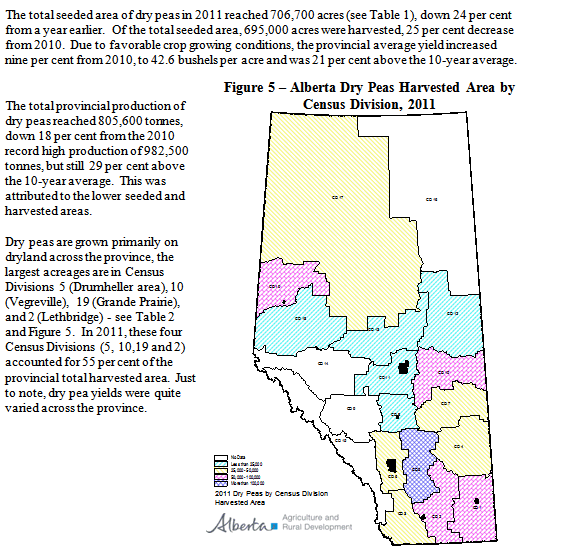
Mustard Seed
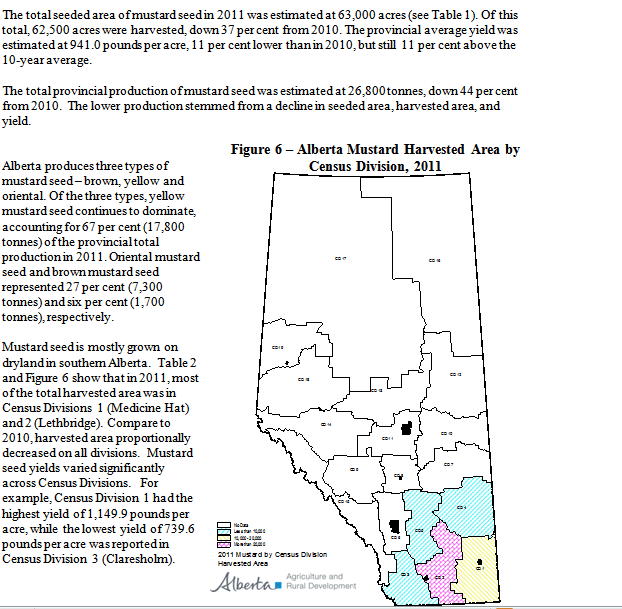
Dry beans
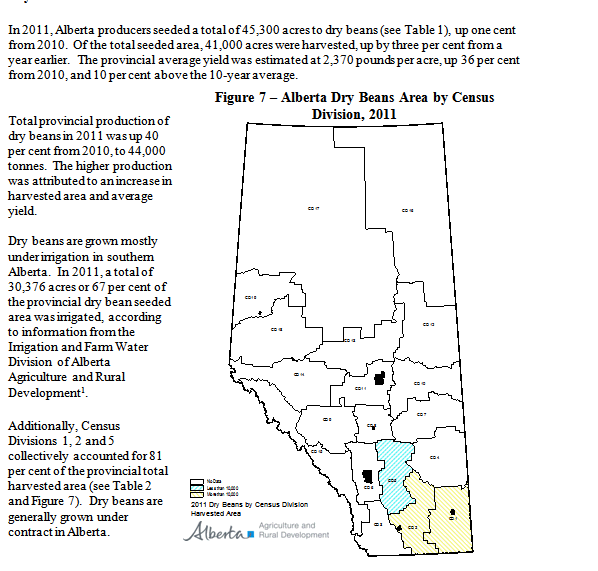
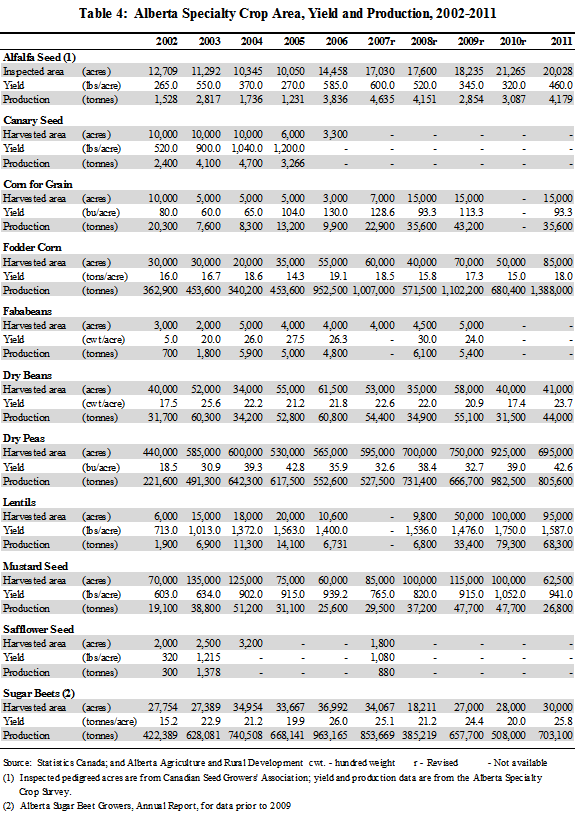
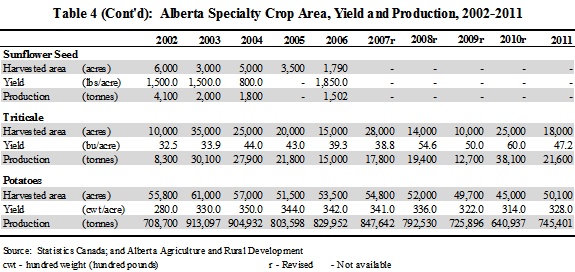
Exports of Alberta Specialty Crops
Dry Peas
In 2011, Alberta dry peas exports, at 254,514 tonnes, accounted for nine per cent of total Canadian exports of 2.9 million tonnes. This was more than double the 97,402 tonnes Alberta exported in 2010 (see Figure 8), and one per cent below the 10-year average (2002 to 2011). In 2011, 65 per cent of Alberta dry peas exports (164,330 tonnes) were to India, followed by China at 75,911 tonnes and Bangladesh at 7,500 tonnes. Table 5 shows the top 10 destinations of Alberta’s dry peas exports.
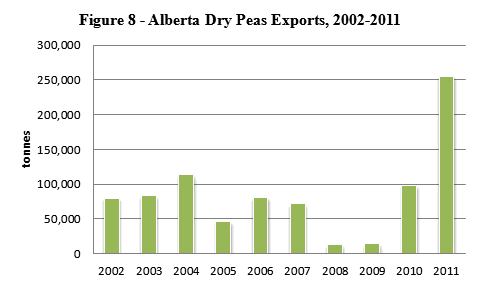
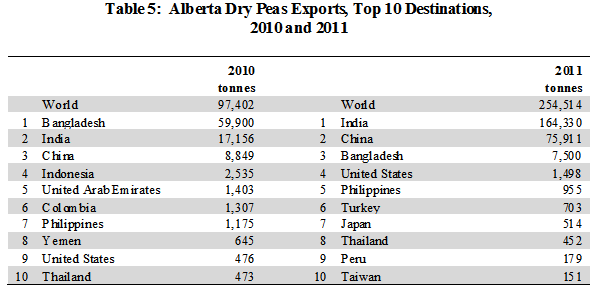
Source: Statistics Canada
Mustard Seed
In 2011, Alberta mustard seed exports, at 38,711 tonnes, accounted for 30 per cent of total Canadian exports of 129,465 tonnes. This was up 24 per cent compared to 31,214 tonnes in 2010 (see Figure 9), and 48 per cent above the 10-year average. In 2011, Alberta exported 27,866 tonnes of mustard seeds to United States which represented 72 per cent of total Alberta exports to the world, followed by Japan with 4,855 tonnes, and Thailand with 1,992 tonnes. Table 6 shows the top 10 destinations of Alberta’s mustard seed exports.
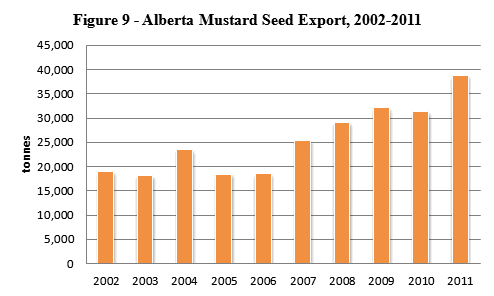
Source: Statistics Canada
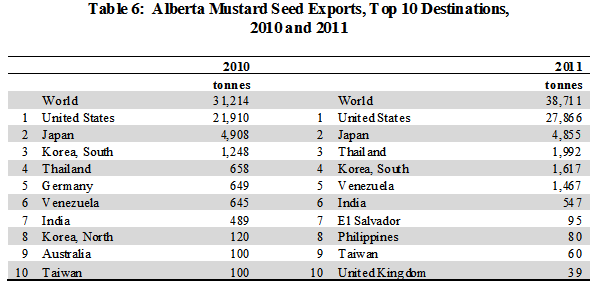
Source: Statistics Canada
Dry Beans
Alberta accounted for 12 per cent of total Canadian dry beans exports (217,119 tonnes) in 2011. Alberta exported 25,147 tonnes of dry beans, up 34 per cent compared to 18,721 tonnes in 2010 (see Figure 10). Dry beans exports were 27 per cent below the 10-year average. In 2011, Alberta exported 19,199 tonnes of dry beans to United States which represented 76 per cent of total Alberta exports to the world, followed by Greece with 3,158 tonnes and France with 522 tonnes. Table 7 shows the top 10 destinations of Alberta’s dry beans exports.
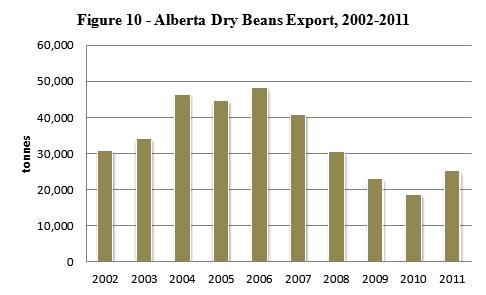
Source: Statistics Canada
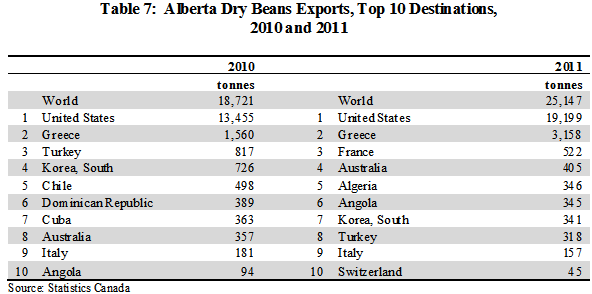
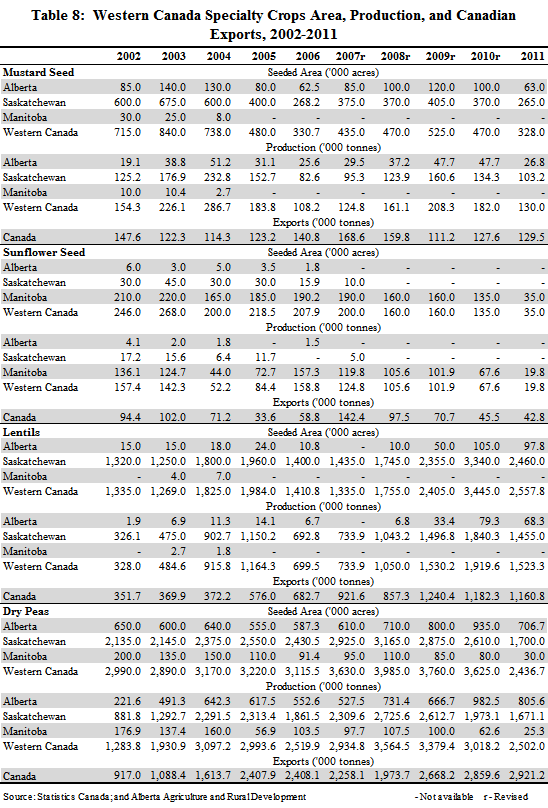
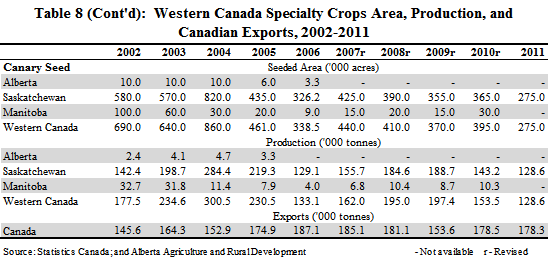
Markets for Selected Specialty Crops
By: Charlie Pearson
Field Peas
Yellow edible pea prices have held in the $8 to $9 per bushel range over the 2012 fall, similar to a year ago but above the five year average. Canadian field pea production in 2012 was estimated to be about 2.8 million tonnes, up 13 percent from 2011.
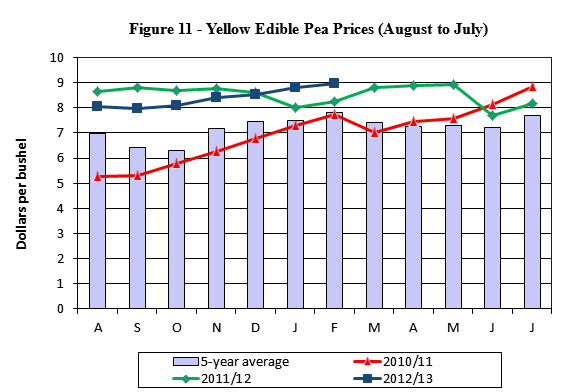
Source: Alberta Agriculture and Rural Development
Lentils
Large seeded green lentils (Laird types) have declined into the 20 cents per pound range, well under the 24 cent per pound average over the past crop year. Western Canadian lentil production in 2012 is estimated to be 1.5 million tonnes, similar to 2011.
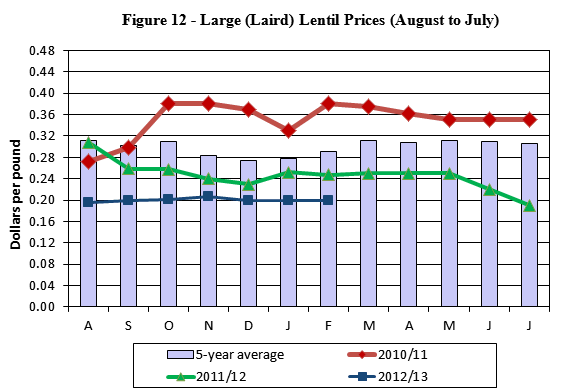
Source: Alberta Agriculture and Rural Development
Chick peas
Kabuli chickpea prices have mostly held around 35 cents per pound over the 2012 fall, similar to the 5 year average. Western Canadian chickpea production in 2012 was estimated to be 158,000 tonnes, up almost 84 percent from 2012.
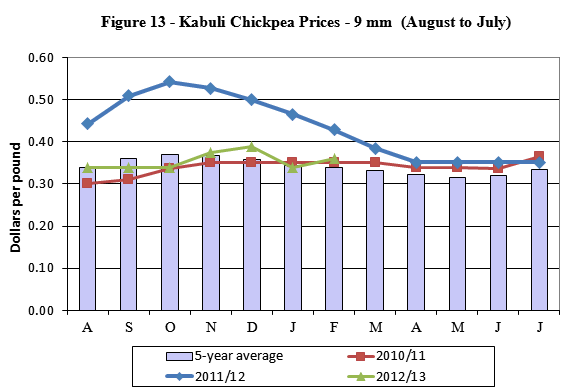
Source: Alberta Agriculture and Rural Development
Canary Seed
Western Canadian canary seed prices ranged from 24 to 28 cents per pound range the 2012 fall, similar to the same period a year ago but well above the 5 year average. Canadian canary seed production in 2012 is estimated to be 130,000 tonnes, similar to 2011.
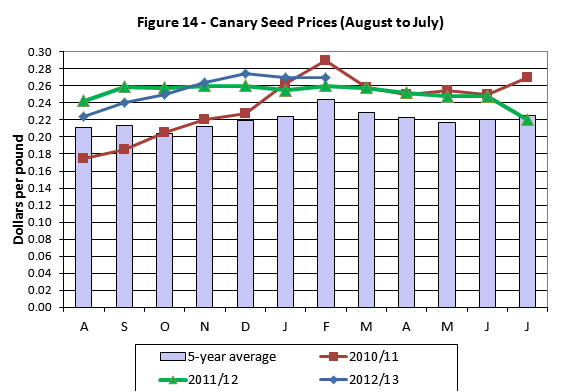
Source: Alberta Agriculture and Rural Development
Mustard Seed
Brown and yellow mustard prices have held around 32 and 35 cents per pound respectively the 2012 fall, similar to this past year. Oriental mustard prices have been in the 25 to 26 cents per pound range. Western Canadian mustard production in 2012 is estimated by Statistics Canada to be 119,000 tonnes, down 8 percent from 2011.
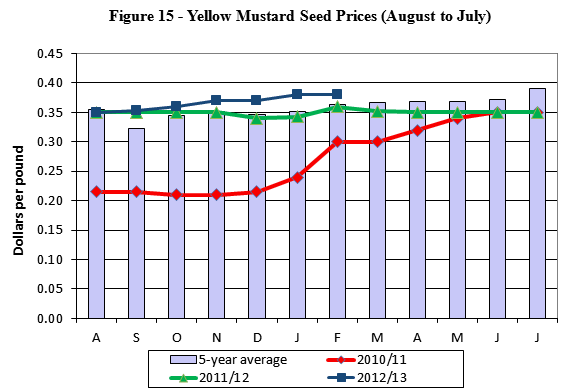
Source: Alberta Agriculture and Rural Development
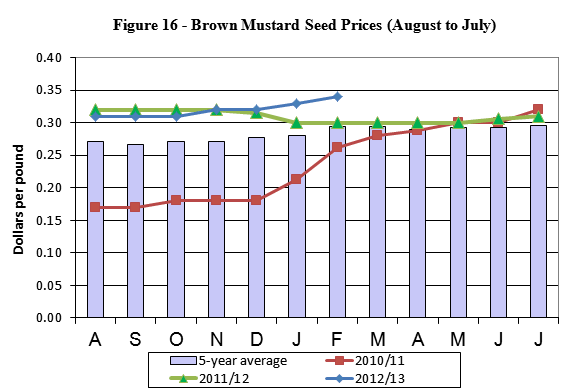
Source: Alberta Agriculture and Rural Development
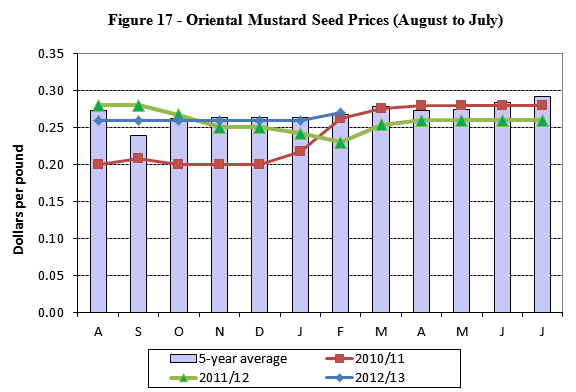
Source: Alberta Agriculture and Rural Development
Economics of Specialty Crop Production
by Emmanuel Anum Laate
Costs and returns for crops, livestock, and several other enterprises have been monitored in the province in an extensive way since the 1960’s. These studies have been viewed as an important tool for assisting producers in their cropping decisions and the federal and provincial governments in developing policies and programs for different farm enterprises. In addition, results from these studies have served to fill some data gaps for other provinces.
The Economics Branch of Alberta Agriculture and Forestry has been conducting economic studies on various farm enterprises for the last several decades. Since the early 1990’s, the Branch has placed greater emphasis on developing costs and returns data on specialty crops for farm diversification purposes. As mentioned above, results from these studies have been very helpful to primary producers when making cropping decisions. Furthermore, individual producers have also used the results from these studies to compare costs and returns and profitability margins of their farms with the group averages from the respective areas in order to develop better management practices. Agri-businesses and other stakeholders have also used the results of the economic studies for feasibility studies.
During the last ten years, area under special crops in Alberta has quite diversified. Figure 18 shows the trend in provincial total seeded area in acres and production in metric tonnes for dry field peas, dry beans and chick peas from 2002 to 2011.
Figure 18 - Total Seeded Area and Production for Dry Field Peas, Dry Beans and Chick Peas in Alberta, 2002-2011
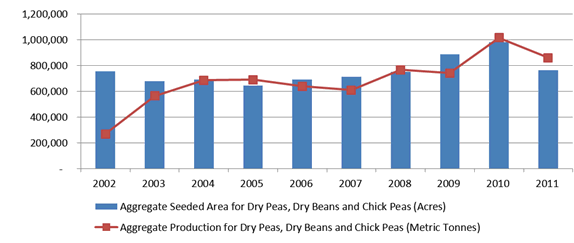
Source: Statistics Canada
In 2011, total production and area seeded to dry peas, dry beans and chick peas decreased by approximately 22 per cent and 15 per cent respectively compared to 2010. The lower production for the 2011 crop was a result of fewer seeded acres, as yields were higher than in 2010. About 92 per cent of the total area was seeded to dry peas in 2011.
Figure 19 shows the trend in the provincial seeded acres of dry peas from 2002 to 2011. Area planted to dry peas in 2011 was 706.7 thousand acres, down 24 per cent from 2010 acres.
Figure 19 - Alberta Dry Peas Seeded Acres, 2002 – 2011
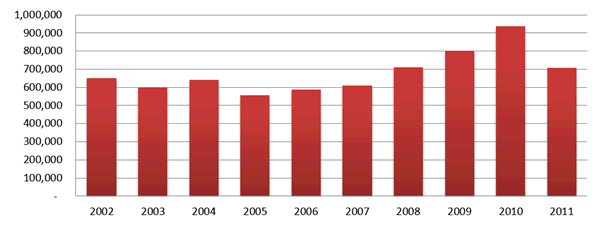
Source: Statistics Canada
Figure 20 shows area seeded to dry beans and chick peas in Alberta over the period 2002 to 2011. Dry beans seeded acres in 2011 was up about one per cent compared to the 2010 crop. Most of the dry beans are grown under contract on irrigated land in southern Alberta.
Figure 20 - Alberta Dry Beans and Chick Peas Seeded Acres, 2002 – 2011
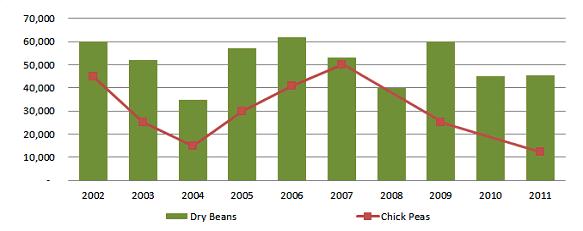
Source: Statistics Canada
In 2008 and 2010 area planted to chick peas decreased considerably thus Statistics Canada had only a few producers to report. Therefore no actual data on seeded acres was published for 2008 and 2010. The changes in chick pea acreage over the last decade could be attributed to drought concerns, crop diseases, and production in major importing countries.
Additionally, producer interest in other specialty crops, including caraway, buckwheat, coriander, borage, herbs and spices, continues to grow.
Tables 9, 10 and 11 present estimates of 2011 production costs and returns for dry field peas, dry beans and chick peas (desi and kabuli) respectively. Readers are cautioned to use these costs as guidelines because costs and returns could vary significantly from one operation to another.
Table 9 Production Costs and Returns for Dry Peas
Dark Brown Soil Zone, 2011
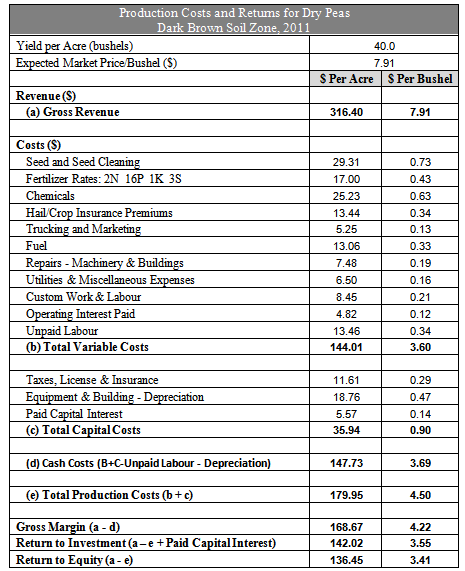
Note: Returns per acre would vary with yield and price.
Source: Alberta Agriculture and Rural Development
For more information contact:
Emmanuel Anum Laate (780-422-4054)
Table 10 Production Costs and Returns for Dry beans
Dark Brown Soil Zone, 2011
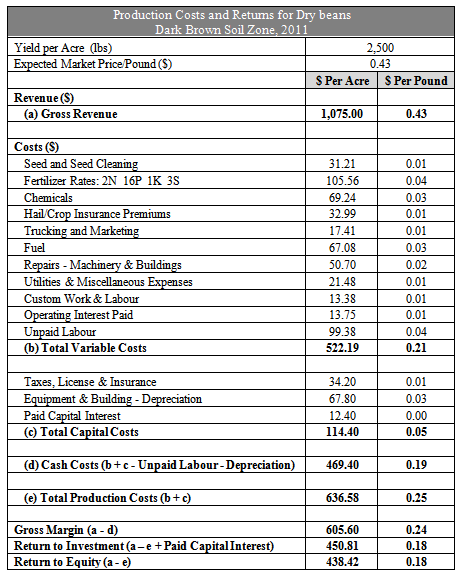
Note: Returns per acre would vary with yield and price.
Source: Alberta Agriculture and Rural Development
For more information contact:
Emmanuel Anum Laate (780-422-4054)
Table 11 Production Costs and Returns for Desi and Kabuli
Chick Peas, 2011
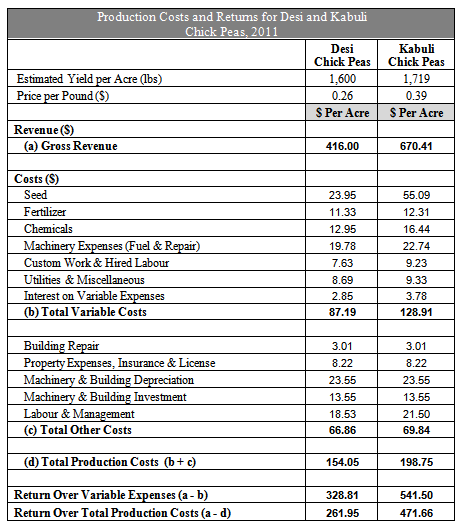
Note: Returns per acre would vary with yield and price.
Source: Alberta Agriculture and Rural Development
For more information contact:
Emmanuel Anum Laate (780-422-4054)
Acknowledgment
The Statistics and Data Development Section of Alberta Agriculture and Forestry wishes to thank all of the producers who participated in the Alberta 2011 Specialty Crop Survey conducted in the winter of 2011/2012. Without their cooperation and assistance, this report would not have been possible.
Several ARD staff members have made significant contributions to the successful completion and dissemination of this report. Those staff include Charlie Pearson of Competitiveness and Market Analysis Branch, Emmanuel Laate of Economics Section, Reynold Jaipaul, Melodie Mynzak, Marion Harry, Guangzhi Liu, Gail Atkinson and Marian Elson of Statistics and Data Development Section.
Lukas Matejovsky
Crop Statistician
Alberta Agriculture and Forestry
Economics and Competitiveness Branch
Statistics and Data Development Section
#300, 7000 -113 Street
Edmonton, Alberta T6H 5T6
Phone: 780-422-2887
Fax: 780-427-5220
Contacts
For additional information relating to the various sections of this report, please do not hesitate to contact the subject area specialist referenced under each section.
This report is also available on the Internet at:
http://www1.agric.gov.ab.ca/$department/deptdocs.nsf/all/sdd12584
For additional copies of this report, please contact:
Alberta Agriculture and Forestry
Economics and Competitiveness Branch
Statistics and Data Development Section
#302, 7000 -113 Street
Edmonton, Alberta T6H 5T6
Phone: 780-422-2887
Fax: 780-427-5220
ISSN 1701-3143 (Print)
ISSN 1927-7830 (Online)
ISBN 978-0-7732-6090-0 (Print)
ISBN 978-0-7732-6091-7 (Online)
Full report in pdf file |
|